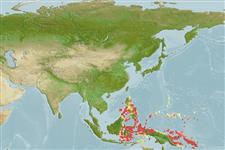>
Eupercaria/misc (Various families in series Eupercaria) >
Labridae (Wrasses) > Cheilininae
Etymology: Pseudocheilinops: Greek, pseudes = false + Greek, cheilos = lip + Greek, ops = appearance (Ref. 45335).
More on author: Schultz.
Environment: milieu / climate zone / depth range / distribution range
Ecologia
marinhas associadas(os) a recifes; intervalo de profundidade 5 - 15 m (Ref. 90102). Tropical; 19°N - 8°S
Western Central Pacific: southern Philippines and Celebes (Indonesia) to Palau.
Tamanho / Peso / Idade
Maturity: Lm ? range ? - ? cm
Max length : 6.5 cm TL macho/indeterminado; (Ref. 48636)
Descrição breve
Chaves de identificação | Morfologia | Morfometria
Espinhos dorsais (total) : 9; Raios dorsais moles (total) : 11; Espinhos anais: 3; Raios anais moles: 9.
Mainly found in still coastal waters, where brittle corals grow high. Occurs in small groups that feed actively among the lower and dead parts of the corals with coralline algae. Easily overlooked because of its small size. Length to 6.5 cm, but usually much smaller (Ref. 48636). Always hides or stays close to its shelter (Ref. 90102). A secretive species. Feeds on amphipods and other small invertebrates. Rarely found in the aquarium trade.
Life cycle and mating behavior
Maturidade | Reprodução | Desova | Ovos | Fecundidade | Larvas
Oviparous, distinct pairing during breeding (Ref. 205).
Westneat, M.W., 2001. Labridae. Wrasses, hogfishes, razorfishes, corises, tuskfishes. p. 3381-3467. In K.E. Carpenter and V. Niem (eds.) FAO species identification guide for fishery purposes. The living marine resources of the Western Central Pacific. Vol. 6. Bony fishes part 4 (Labridae to Latimeriidae), estuarine crocodiles. FAO, Rome. (Ref. 9823)
Categoria na Lista Vermelha da IUCN (Ref. 130435: Version 2024-1)
Ameaça para o homem
Harmless
Utilização humana
Pescarias: sem interesse
Ferramentas
Relatórios especiais
Descarregue XML
Fontes da internet
Estimates based on models
Preferred temperature (Ref.
123201): 28.5 - 29.4, mean 28.9 °C (based on 681 cells).
Phylogenetic diversity index (Ref.
82804): PD
50 = 1.0000 [Uniqueness, from 0.5 = low to 2.0 = high].
Bayesian length-weight: a=0.01585 (0.00700 - 0.03587), b=2.95 (2.76 - 3.14), in cm total length, based on LWR estimates for this (Sub)family-body shape (Ref.
93245).
Nível Trófico (Ref.
69278): 3.4 ±0.45 se; based on food items.
Resiliência (Ref.
120179): Elevada, tempo mínimo de duplicação da população menor que 15 meses (Preliminary K or Fecundity.).
Fishing Vulnerability (Ref.
59153): Low vulnerability (10 of 100).
Nutrients (Ref.
124155): Calcium = 172 [97, 337] mg/100g; Iron = 1.04 [0.57, 2.01] mg/100g; Protein = 18.3 [15.4, 20.6] %; Omega3 = 0.166 [0.093, 0.292] g/100g; Selenium = 20.6 [10.4, 40.8] μg/100g; VitaminA = 165 [48, 681] μg/100g; Zinc = 2.5 [1.6, 4.0] mg/100g (wet weight);
